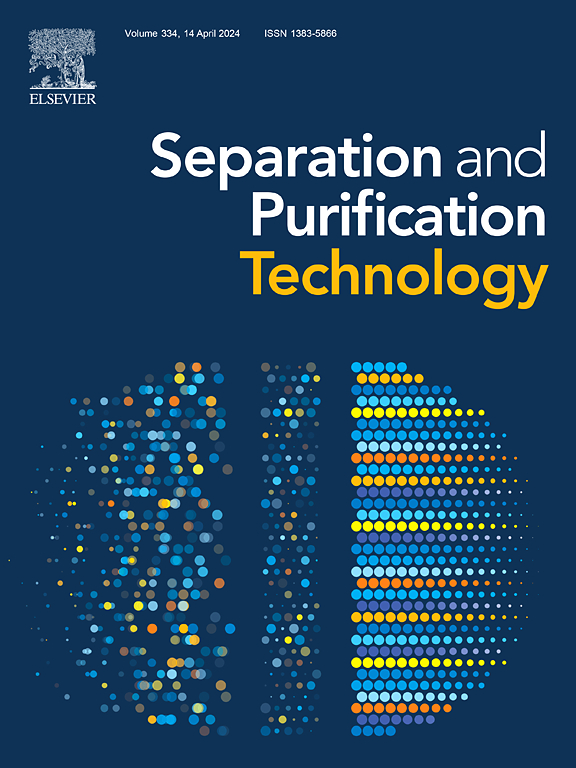绿色合成强力壳聚糖基水凝胶珠去除水中铬(VI)
IF 8.1
1区 工程技术
Q1 ENGINEERING, CHEMICAL
引用次数: 0
摘要
壳聚糖基吸附剂被广泛认为是水净化的有前途的候选者。然而,在其制造阶段,潜在的环境负担,如过多的有机溶剂释放和高能耗,在很大程度上被忽视了。在此,我们提出了一种相对简单和绿色的合成策略来构建具有高正电荷密度的壳聚糖基水凝胶珠(CHB-M)。具体而言,制备过程在室温下进行,在空气气氛下,不使用环己烷等有机溶剂,不使用加热能量或惰性气体。更重要的是,只需改变阳离子含量和滴注方式,CHB-M的电荷密度和珠粒大小就可以得到很好的调节。制备的CHB-M不仅具有较高的机械强度,而且对阴离子污染物Cr(VI)具有优异的吸附性能,吸附量为234.99 mg/g (pH为3.0,室温作用24 h),优于以往报道的大多数吸附剂。以CHB-M为过滤材料的连续流吸附系统运行1440 h净化微污染水。该系统的Cr(VI)去除率一直保持在99% %以上,处理能力为24 L/g,证明了CHB-M在实际应用中的潜力。能源和经济分析表明,该合成工艺具有较高的能源效率和经济效益。提出的壳聚糖基水凝胶合成绿色策略为开发真正环保的吸附剂用于可持续水净化提供了新的视角。本文章由计算机程序翻译,如有差异,请以英文原文为准。

Green synthesis of robust chitosan-based hydrogel beads for Cr(VI) removal from water
Chitosan-based adsorbents have been widely regarded as promising candidates for water purification. However, the potential environmental burdens, such as excessive organic solvent release and high energy consumption, associated with their manufacturing stage are largely overlooked. Herein, we propose a relatively facile and green synthesis strategy for constructing a robust chitosan-based hydrogel bead (CHB-M) with high positive charge density. Specifically, the preparation process was conducted at room temperature under air atmosphere, without the use of organic solvents like cyclohexane, heating energy or inert gas. More importantly, the charge density and bead size of CHB-M can be finely tuned by simply changing the introduced cationic content and dripping method, respectively. The resultant CHB-M not only exhibited high mechanical strength but also manifested outstanding adsorption performance toward anionic pollutant Cr(VI) with an adsorption capacity of 234.99 mg/g (at pH 3.0 and room temperature for 24 h), superior to that of most previously reported adsorbents. Furthermore, a continuous flow adsorption system using CHB-M as a filter material was operated for 1440 h to purify micropolluted water. The system consistently achieved over 99 % of Cr(VI) removal efficiency with a treatment capacity of 24 L/g, demonstrating the potential of CHB-M for practical applications. Energy and economic analyses revealed the high energy efficiency and economic benefits of the synthesis process. The proposed green strategy for chitosan-based hydrogel synthesis provides a new perspective on developing truly environmentally friendly adsorbents for sustainable water purification.
求助全文
通过发布文献求助,成功后即可免费获取论文全文。
去求助
来源期刊

Separation and Purification Technology
工程技术-工程:化工
CiteScore
14.00
自引率
12.80%
发文量
2347
审稿时长
43 days
期刊介绍:
Separation and Purification Technology is a premier journal committed to sharing innovative methods for separation and purification in chemical and environmental engineering, encompassing both homogeneous solutions and heterogeneous mixtures. Our scope includes the separation and/or purification of liquids, vapors, and gases, as well as carbon capture and separation techniques. However, it's important to note that methods solely intended for analytical purposes are not within the scope of the journal. Additionally, disciplines such as soil science, polymer science, and metallurgy fall outside the purview of Separation and Purification Technology. Join us in advancing the field of separation and purification methods for sustainable solutions in chemical and environmental engineering.
 求助内容:
求助内容: 应助结果提醒方式:
应助结果提醒方式:


